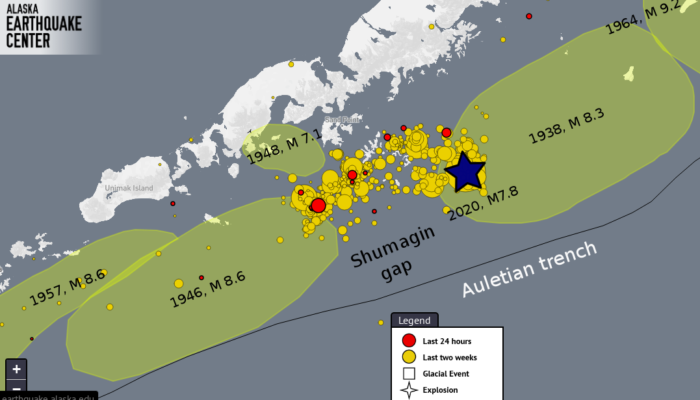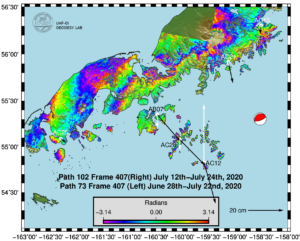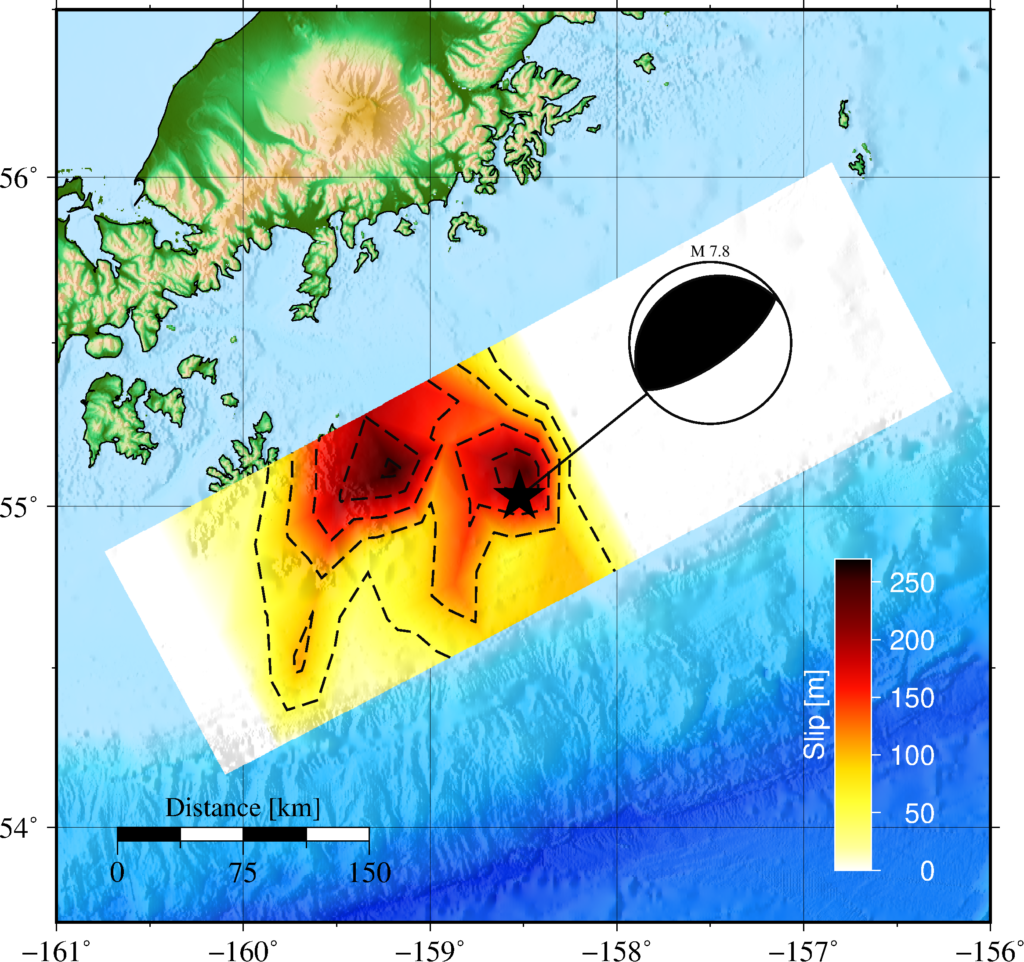
On July 22nd, Alaska was the scene of last month’s largest earthquake, a Mw 7.8 earthquake that hit the Aleutian Islands, offshore the Alaska Peninsula. The hypocenter location, tectonic setting and focal mechanism suggest a megathrust earthquake. The hypocenter of the so called Simeonof earthquake is located at the western edge of the historical 1938 earthquake (M8.3) slip zone, near the Shumagin seismic gap (Davies et al., 1981; Nada, 2020, Figure 1). The Shumagin gap is the only unruptured part of the Aleutian megathrust subduction zone since early 20th century, between rupture zones of the 1938 and 1946 great earthquakes (Gardine, 2017).
The Aleutian Islands is well-known for its strong seismic activity along the 4000-km-long Aleutian Trench, a product of the subduction of the Pacific Plate beneath the North American Plate.

Figure 2 | Tsunami travel time contours in hours after the Simeonof earthquake. Credit: NOAA / U.S. Tsunami Warning System
During the last 100 years, several great megathrust earthquakes (M>8.0) are recorded in this region. These events generally have a strong tsunamigenic potential. Just after the Simeonof earthquake, the tsunami alert triggered in the Pacific (Figure 2). As previous large events in this region, no significant damage was reported. GPS observations and InSAR analysis show a maximum of 33 cm uplift (Figure 3). Preliminaries slip distribution using the SLIPNEAR method (Delouis, 2014) shows a main rupture of about 200 km length with a maximum slip of 264 cm. In addition, the main rupture propagates to the west, which is compatible with the relatively small tsunami amplitudes recorded (Figure 4).

Figure 3 | Kinematic GPS solutions and InSAR results of the Simeonof earthquake. GPS site AC12 shows the largest uplift of about 33 cm and about 25 cm horizontal motion. Credits: Ronni Grapenthin and Logan Fusso (more information see: http://www.grapenthin.org/notes/2020_07_24_Simeonof_eq/)
Within two weeks of the main event, the Alaska Earthquake Center has recorded 960 aftershocks, seismicity that you can follow on their website https://earthquake.alaska.edu/event/0209dha24u

Figure 4 | Preliminary focal mechanism and slip distribution model. Modeled on July 22 using SLIPNEAR method. Credit: Bertrand Delouis @BertrandDelouis
These kinds of earthquakes are quite common for the Aleutian megathrust. The location of the Simeonof mainshock and its aftershocks distribution near the Shumagin seismic gap leaves a lot of space for discussion and scientific questions (Nadin, 2020). However, this event does not necessarily reduce the risk of having a M8.0 event breaking the unruptured segment in the next years.
TOP 3 – July earthquakes
Simeonof earthquake – 22nd July – M 7.8
Papua New Guinea earthquake – 17th July – 7.0
Indonesia earthquake – 6th July – 6.7
References
- Davies, J., Sykes, L., House, L., Jacob, K. (1981). Shumagin seismic gap, Alaska Peninsula: History of great earthquakes, tectonic setting, and evidence for high seismic potential, J. Geophy Research, 86,B5,3821-3855.
- Delouis, B.; FMNEAR: Determination of Focal Mechanism and First Estimate of Rupture Directivity Using Near‐Source Records and a Linear Distribution of Point Sources. Bulletin of the Seismological Society of America; 104 (3): 1479–1500. doi: https://doi.org/10.1785/0120130151
- Gardine, M. (2017). A new perspetive on seismic hazards in the Shumagin gap, https://earthquake.alaska.edu/new-perspective-seismic-hazards-shumagin-gap
- Nadin, E., 2020, Does Alaska’s magnitude-7.8 Simeonof earthquake finally close a seismic gap?, Temblor, http://doi.org/10.32858/temblor.106
- UNAVCO- Data event response to the July 22, 2020 M7.8 Simeonof, Alaska Earthquake
This blog post was written by ECS representative Javier Ojeda
with revisions from ECS representative Michaela Wenner
